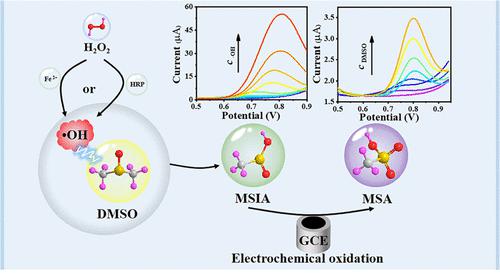Our official English website, www.x-mol.net, welcomes your feedback! (Note: you will need to create a separate account there.)
Dimethyl Sulfoxide: An Ideal Electrochemical Probe for Hydroxyl Radical Detection
ACS Sensors ( IF 8.9 ) Pub Date : 2024-02-22 , DOI: 10.1021/acssensors.3c02644 Haining Cui 1 , Jinxin Ma 1 , Youyi Liu 2 , Chan Wang 1 , Qijun Song 1
ACS Sensors ( IF 8.9 ) Pub Date : 2024-02-22 , DOI: 10.1021/acssensors.3c02644 Haining Cui 1 , Jinxin Ma 1 , Youyi Liu 2 , Chan Wang 1 , Qijun Song 1
Affiliation

|
In situ and real-time determination of hydroxyl radicals (•OH) in physiological and pathological processes is a great challenge due to their ultrashort lifetime. Herein, an electrochemical method was developed by using dimethyl sulfoxide (DMSO) as a trapping probe for rapid determination of •OH in aqueous solution. When DMSO reacted with •OH, an intermediate product methane sulfinic acid (MSIA) was formed, which can be electrochemically oxidized to methanesulfonic acid (MSA) on the glassy carbon electrode (GCE), resulting in a distinct voltammetric signal that is directly proportional to the concentration of •OH. Other commonly encountered reactive oxygen species (ROS), including hypochlorite anions (ClO–), superoxide anions (O2•–), sulfate radicals (SO4•–), and singlet oxygen (1O2), have showed no interference for •OH determination. Thus, an electrochemical method was developed for the determination of •OH, which exhibits a wide linear range (0.4–5120 μM) and a low limit detection of 0.13 μM (S/N = 3) and was successfully applied for the quantification of •OH in aqueous extracts of cigarette tar (ACT). Alternatively, the same reaction mechanism is also applicable for the determination of DMSO, in which a linear range of 40–320 μM and a detection limit 13.3 μM (S/N = 3) was achieved. The method was used for the evaluation of DMSO content in cell cryopreservation medium. This work demonstrated that DMSO can serve as an electrochemical probe and has valuable application potential in radical study, biological research, and environmental monitoring.
中文翻译:

二甲亚砜:用于羟基自由基检测的理想电化学探针
由于其超短的寿命,原位实时测定生理和病理过程中的羟自由基(· OH)是一个巨大的挑战。本文开发了一种电化学方法,使用二甲基亚砜(DMSO)作为捕获探针快速测定水溶液中的· OH。当 DMSO 与 OH 反应时,会形成中间产物甲亚磺酸 (MSIA),它可以在玻碳电极 (GCE) 上电化学氧化为甲磺酸 (MSA),从而产生明显的伏安信号,该信号与• OH的浓度。其他常见的活性氧 (ROS),包括次氯酸根阴离子 (ClO – )、超氧阴离子 (O 2 ·– )、硫酸根 (SO 4 ·– ) 和单线态氧 ( 1 O 2 ),均未表现出干扰。• OH 测定。因此,开发了一种用于测定• OH 的电化学方法,该方法具有较宽的线性范围 (0.4–5120 μM) 和 0.13 μM (S/N = 3) 的检测下限,并成功应用于 • 的定量。烟焦油水提取物 (ACT) 中的 OH。另外,相同的反应机制也适用于 DMSO 的测定,线性范围为 40-320 μM,检测限为 13.3 μM (S/N = 3)。该方法用于细胞冻存培养基中DMSO含量的测定。这项工作表明DMSO可以作为电化学探针,在基础研究、生物研究和环境监测中具有有价值的应用潜力。
更新日期:2024-02-22
中文翻译:

二甲亚砜:用于羟基自由基检测的理想电化学探针
由于其超短的寿命,原位实时测定生理和病理过程中的羟自由基(· OH)是一个巨大的挑战。本文开发了一种电化学方法,使用二甲基亚砜(DMSO)作为捕获探针快速测定水溶液中的· OH。当 DMSO 与 OH 反应时,会形成中间产物甲亚磺酸 (MSIA),它可以在玻碳电极 (GCE) 上电化学氧化为甲磺酸 (MSA),从而产生明显的伏安信号,该信号与• OH的浓度。其他常见的活性氧 (ROS),包括次氯酸根阴离子 (ClO – )、超氧阴离子 (O 2 ·– )、硫酸根 (SO 4 ·– ) 和单线态氧 ( 1 O 2 ),均未表现出干扰。• OH 测定。因此,开发了一种用于测定• OH 的电化学方法,该方法具有较宽的线性范围 (0.4–5120 μM) 和 0.13 μM (S/N = 3) 的检测下限,并成功应用于 • 的定量。烟焦油水提取物 (ACT) 中的 OH。另外,相同的反应机制也适用于 DMSO 的测定,线性范围为 40-320 μM,检测限为 13.3 μM (S/N = 3)。该方法用于细胞冻存培养基中DMSO含量的测定。这项工作表明DMSO可以作为电化学探针,在基础研究、生物研究和环境监测中具有有价值的应用潜力。



























 京公网安备 11010802027423号
京公网安备 11010802027423号